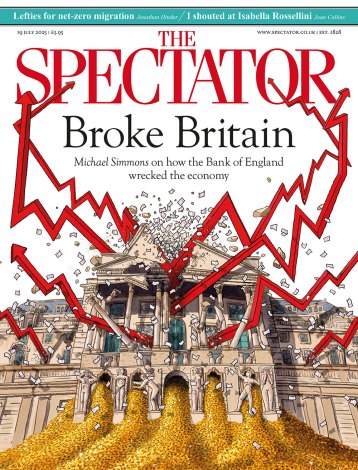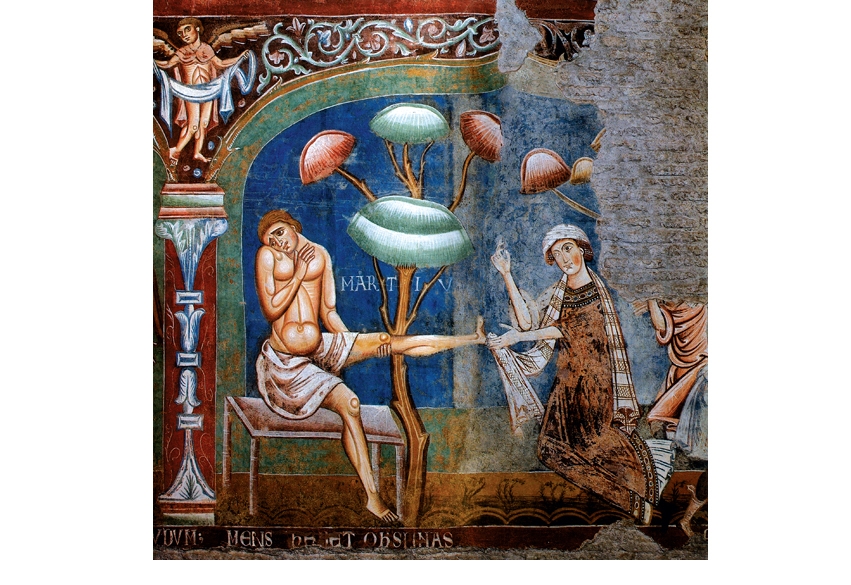Rome contains many hidden treasures, but the most remarkable of the lot is concealed on the Caelian Hill, above the Colosseum, in the medieval monastery of Santi Quattro Coronati. It’s a cycle of frescoes dating from around 1250. It is extremely rare for painting from this period to survive anywhere, but it’s even rarer in Rome, where the rebuilding of the city by the Counter-Reformation popes destroyed almost all medieval painting.
The paintings are in a vast vaulted gothic hall, the walls of which — about 800 square metres of them — were originally completely covered in frescoes. About half the original paintings remain: an earthquake, and the construction of additional windows, have destroyed the rest. But what survives is so impressive that it has been called ‘the medieval Sistine Chapel’ — which it’s not: it’s not that amazing. But it is wonderful, so the hyperbole is pardonable.
Almost every other surviving medieval fresco cycle depicts scenes from the Old and New Testament, or at least episodes from the life of a saint, reflecting the critical role of painting in providing religious instruction for the illiterate. But these pictures aren’t overtly religious. They depict the seasons, the zodiac, the labours of the months, and the vices and the virtues. The virtues are depicted as knights in chain mail with saints and prophets on their shoulders, whispering wisdom into their ears. There’s what looks to be an image of Mithras sacrificing a bull. There are also personifications of the seven liberal arts, and a large portrait of Solomon, sitting in judgment, but looking much more like a medieval ruler than an Old Testament king.
The impression that this is a secular cycle may, however, be misleading. Professor Andreina Draghi, the greatest authority on the cycle and the woman who discovered it, points out that all of the images can be fitted into the system of Christian symbolism then prevalent, and she quotes various medieval writers to show that the labours of the months had a complicated interpretation involving the spiritual journey of every Christian through life to death, judgment and (perhaps) heaven. Even the image of Mithras may have been interpreted religiously. It is paired with depictions of the sun and the moon, which, Prof. Draghi suggests, represent the light of the Christian faith that will ultimately overcome the evil in the world — which is what Mithras and the bull represented.
Whatever the ‘real’ meaning of the images — and many of those who looked at them even in the Middle Ages may not have known — there’s no doubt that they were commissioned by churchmen, and ones who had one overriding goal: proving the supremacy of the Church over secular government. The popes were locked in a life-or-death struggle with Frederick II, the ruler of Sicily, most of southern Italy, and, nominally, of large chunks of Germany as well. Frederick wanted to revive the supreme power of the emperor, the ‘pontifex maximus’ of antiquity. Frederick was excommunicated and eventually formally ‘deposed’ as emperor by the Papal Court for his insistence that the Church should be subordinate to him — as well as for failing to conduct a properly violent Crusade (he won back the city of Jerusalem by negotiation instead), and for defeating the papal army, besieging Rome and imprisoning a group of cardinals.
Papal denunciations did not dent Frederick’s power significantly, which may have been why the Church’s most senior officials were keen to make sure that as many people as possible understood that Frederick’s claims to authority over the Church were bogus. Underneath the hall at Santi Quattro Coronati is a chapel frescoed with images of the legend of Saint Sylvester. It shows the Roman emperor Constantine bowing to the authority of the early Church, and handing control over his empire to Church officials, an event recorded in the notorious ‘Donation of Constantine’. The document was exposed as a forgery in the mid 15th century but, until then, it was used as the foundation of the Church’s claims to supremacy.
It was while contemplating the Saint Sylvester cycle more than a decade ago that Prof. Draghi concluded that somewhere it must have a counterpart: it was an incomplete assertion of ecclesiastical authority. It didn’t spell out matters such as just how essential obedience to the Church is to salvation.
Prof. Draghi thought that the hall above, then completely covered in pale blue plaster, might have been the place where the other frescoes had been painted. Santi Quattro Coronati was, in the 13th century, a monastery, a castle, a palace and a centre for the administration of justice. It was also a place of pilgrimage, having a prodigious collection of relics: the bones of more than 12 saints and martyrs could be venerated there, including those of Linus, St Peter’s first successor as pope. It was controlled by Stefano Conti, one of the highest-ranking cardinals in the Papal Curia and a member of the Conti family, which provided three popes in the first half of the 13th century (one of them Stefano’s brother), and which controlled most of the top positions in the Papal Court.
All those facts suggested to Prof. Draghi that it would be worth trying to remove the plaster in the hall to see if there was anything underneath it. To her delight, the cycle was revealed as the plaster came off.
It took several years to remove all the plaster without damaging the paintings underneath. They turned out to be in astoundingly good condition: brighter, clearer and easier to read than practically every other medieval fresco cycle. They had been covered up within a century of being painted, possibly after one of the outbreaks of plague struck the monastery. Or perhaps the damage inflicted by an earthquake in 1349 was so great that, rather than restoring the frescoes, it was decided just to cover them up. Whatever the reason, plastering over the paintings ensured that, for at least the next 500 years, they were protected from light, damp and restorers.
That was very fortunate. The images are much more sophisticated, and the level of skill required to produce them is much higher, than the frescoes in the chapel below. Why? Prof. Draghi thinks the answer is that they have never been restored: the frescoes in the San Sylvester chapel were restored many times from the 18th century onwards, usually by restorers convinced that medieval painting was very crude — so that’s how they decided they would make it look.
The frescoes in the hall above demonstrate how mistaken that view of medieval painting is. There are some astonishingly delicate and beautiful images, as well as some very powerful ones. The artists — and more than one team worked on the paintings — were moving towards a greater naturalism, which would place the human figure more realistically in an illusion of three-dimensional space created on a flat surface. The degree to which they succeeded provides evidence for the idea that it was Roman painters of the 13th century who made the first strides towards the naturalism that would, in the 15th, become the salient characteristic of the Renaissance — which would mean that Rome, rather than Florence, was the source of the most important development in art in Europe in more than 1,000 years.
The paintings in the hall at Santi Quattro Coronati should be seen by everyone interested in the history of art. Unfortunately, they can’t be viewed at all, by anyone. Santi Quattro Coronati is home to a closed order of Augustinian nuns who have vowed never to have any contact with the outside world. Getting to the hall requires, at present, going through some of their living quarters. When I attempted to visit, I had Prof. Draghi backing me, as well as several other heavyweight figures from the Italian art world, including the head of the Vatican’s art department. But it was no good: the nuns refused to let me, or anyone else, into the hall. ‘They have become more extreme since we were allowed to restore it,’ Prof. Draghi told me. ‘They have become more fundamentalist. There is a surprising number of Italian women who want to join closed orders, and who are determined to abide by the rule of the founder to the letter.’
You can get into Saint Sylvester’s chapel on the ground floor, but the gothic hall with the magnificent frescoes above is out of bounds. There was a plan to build an external staircase to let art-lovers into the hall without having to interact with the nuns. But nothing has come of it, and five years on it appears that the plan has been abandoned. The Italian press reported earlier this year that the Vatican had simply stopped answering questions on the topic. If you want to get an idea of what the cycle is like, you will have to buy Prof. Draghi’s magnificent book, Gli affreschi dell’Aula gotica nel Monastero dei Santi Quattro Coronati — Una storia ritrovata (Skira, 2006), which is sumptuously illustrated with hundreds of close-up photographs of every part of the surviving frescoes. It’s not the same as being able to visit the hall yourself. But it’s a lot better than nothing.





Comments